Xinxing Xu
Reinforce-Ada: An Adaptive Sampling Framework for Reinforce-Style LLM Training
Oct 06, 2025Abstract:Reinforcement learning applied to large language models (LLMs) for reasoning tasks is often bottlenecked by unstable gradient estimates due to fixed and uniform sampling of responses across prompts. Prior work such as GVM-RAFT addresses this by dynamically allocating inference budget per prompt to minimize stochastic gradient variance under a budget constraint. Inspired by this insight, we propose Reinforce-Ada, an adaptive sampling framework for online RL post-training of LLMs that continuously reallocates sampling effort to the prompts with the greatest uncertainty or learning potential. Unlike conventional two-stage allocation methods, Reinforce-Ada interleaves estimation and sampling in an online successive elimination process, and automatically stops sampling for a prompt once sufficient signal is collected. To stabilize updates, we form fixed-size groups with enforced reward diversity and compute advantage baselines using global statistics aggregated over the adaptive sampling phase. Empirical results across multiple model architectures and reasoning benchmarks show that Reinforce-Ada accelerates convergence and improves final performance compared to GRPO, especially when using the balanced sampling variant. Our work highlights the central role of variance-aware, adaptive data curation in enabling efficient and reliable reinforcement learning for reasoning-capable LLMs. Code is available at https://github.com/RLHFlow/Reinforce-Ada.
Text to Image for Multi-Label Image Recognition with Joint Prompt-Adapter Learning
Jun 12, 2025



Abstract:Benefited from image-text contrastive learning, pre-trained vision-language models, e.g., CLIP, allow to direct leverage texts as images (TaI) for parameter-efficient fine-tuning (PEFT). While CLIP is capable of making image features to be similar to the corresponding text features, the modality gap remains a nontrivial issue and limits image recognition performance of TaI. Using multi-label image recognition (MLR) as an example, we present a novel method, called T2I-PAL to tackle the modality gap issue when using only text captions for PEFT. The core design of T2I-PAL is to leverage pre-trained text-to-image generation models to generate photo-realistic and diverse images from text captions, thereby reducing the modality gap. To further enhance MLR, T2I-PAL incorporates a class-wise heatmap and learnable prototypes. This aggregates local similarities, making the representation of local visual features more robust and informative for multi-label recognition. For better PEFT, we further combine both prompt tuning and adapter learning to enhance classification performance. T2I-PAL offers significant advantages: it eliminates the need for fully semantically annotated training images, thereby reducing the manual annotation workload, and it preserves the intrinsic mode of the CLIP model, allowing for seamless integration with any existing CLIP framework. Extensive experiments on multiple benchmarks, including MS-COCO, VOC2007, and NUS-WIDE, show that our T2I-PAL can boost recognition performance by 3.47% in average above the top-ranked state-of-the-art methods.
An integrated language-vision foundation model for conversational diagnostics and triaging in primary eye care
May 13, 2025Abstract:Current deep learning models are mostly task specific and lack a user-friendly interface to operate. We present Meta-EyeFM, a multi-function foundation model that integrates a large language model (LLM) with vision foundation models (VFMs) for ocular disease assessment. Meta-EyeFM leverages a routing mechanism to enable accurate task-specific analysis based on text queries. Using Low Rank Adaptation, we fine-tuned our VFMs to detect ocular and systemic diseases, differentiate ocular disease severity, and identify common ocular signs. The model achieved 100% accuracy in routing fundus images to appropriate VFMs, which achieved $\ge$ 82.2% accuracy in disease detection, $\ge$ 89% in severity differentiation, $\ge$ 76% in sign identification. Meta-EyeFM was 11% to 43% more accurate than Gemini-1.5-flash and ChatGPT-4o LMMs in detecting various eye diseases and comparable to an ophthalmologist. This system offers enhanced usability and diagnostic performance, making it a valuable decision support tool for primary eye care or an online LLM for fundus evaluation.
Partially Supervised Unpaired Multi-Modal Learning for Label-Efficient Medical Image Segmentation
Mar 07, 2025Abstract:Unpaired Multi-Modal Learning (UMML) which leverages unpaired multi-modal data to boost model performance on each individual modality has attracted a lot of research interests in medical image analysis. However, existing UMML methods require multi-modal datasets to be fully labeled, which incurs tremendous annotation cost. In this paper, we investigate the use of partially labeled data for label-efficient unpaired multi-modal learning, which can reduce the annotation cost by up to one half. We term the new learning paradigm as Partially Supervised Unpaired Multi-Modal Learning (PSUMML) and propose a novel Decomposed partial class adaptation with snapshot Ensembled Self-Training (DEST) framework for it. Specifically, our framework consists of a compact segmentation network with modality specific normalization layers for learning with partially labeled unpaired multi-modal data. The key challenge in PSUMML lies in the complex partial class distribution discrepancy due to partial class annotation, which hinders effective knowledge transfer across modalities. We theoretically analyze this phenomenon with a decomposition theorem and propose a decomposed partial class adaptation technique to precisely align the partially labeled classes across modalities to reduce the distribution discrepancy. We further propose a snapshot ensembled self-training technique to leverage the valuable snapshot models during training to assign pseudo-labels to partially labeled pixels for self-training to boost model performance. We perform extensive experiments under different scenarios of PSUMML for two medical image segmentation tasks, namely cardiac substructure segmentation and abdominal multi-organ segmentation. Our framework outperforms existing methods significantly.
BenchX: A Unified Benchmark Framework for Medical Vision-Language Pretraining on Chest X-Rays
Oct 29, 2024



Abstract:Medical Vision-Language Pretraining (MedVLP) shows promise in learning generalizable and transferable visual representations from paired and unpaired medical images and reports. MedVLP can provide useful features to downstream tasks and facilitate adapting task-specific models to new setups using fewer examples. However, existing MedVLP methods often differ in terms of datasets, preprocessing, and finetuning implementations. This pose great challenges in evaluating how well a MedVLP method generalizes to various clinically-relevant tasks due to the lack of unified, standardized, and comprehensive benchmark. To fill this gap, we propose BenchX, a unified benchmark framework that enables head-to-head comparison and systematical analysis between MedVLP methods using public chest X-ray datasets. Specifically, BenchX is composed of three components: 1) Comprehensive datasets covering nine datasets and four medical tasks; 2) Benchmark suites to standardize data preprocessing, train-test splits, and parameter selection; 3) Unified finetuning protocols that accommodate heterogeneous MedVLP methods for consistent task adaptation in classification, segmentation, and report generation, respectively. Utilizing BenchX, we establish baselines for nine state-of-the-art MedVLP methods and found that the performance of some early MedVLP methods can be enhanced to surpass more recent ones, prompting a revisiting of the developments and conclusions from prior works in MedVLP. Our code are available at https://github.com/yangzhou12/BenchX.
Enhancing Community Vision Screening -- AI Driven Retinal Photography for Early Disease Detection and Patient Trust
Oct 27, 2024Abstract:Community vision screening plays a crucial role in identifying individuals with vision loss and preventing avoidable blindness, particularly in rural communities where access to eye care services is limited. Currently, there is a pressing need for a simple and efficient process to screen and refer individuals with significant eye disease-related vision loss to tertiary eye care centers for further care. An ideal solution should seamlessly and readily integrate with existing workflows, providing comprehensive initial screening results to service providers, thereby enabling precise patient referrals for timely treatment. This paper introduces the Enhancing Community Vision Screening (ECVS) solution, which addresses the aforementioned concerns with a novel and feasible solution based on simple, non-invasive retinal photography for the detection of pathology-based visual impairment. Our study employs four distinct deep learning models: RETinal photo Quality Assessment (RETQA), Pathology Visual Impairment detection (PVI), Eye Disease Diagnosis (EDD) and Visualization of Lesion Regions of the eye (VLR). We conducted experiments on over 10 datasets, totaling more than 80,000 fundus photos collected from various sources. The models integrated into ECVS achieved impressive AUC scores of 0.98 for RETQA, 0.95 for PVI, and 0.90 for EDD, along with a DICE coefficient of 0.48 for VLR. These results underscore the promising capabilities of ECVS as a straightforward and scalable method for community-based vision screening.
UrFound: Towards Universal Retinal Foundation Models via Knowledge-Guided Masked Modeling
Aug 10, 2024Abstract:Retinal foundation models aim to learn generalizable representations from diverse retinal images, facilitating label-efficient model adaptation across various ophthalmic tasks. Despite their success, current retinal foundation models are generally restricted to a single imaging modality, such as Color Fundus Photography (CFP) or Optical Coherence Tomography (OCT), limiting their versatility. Moreover, these models may struggle to fully leverage expert annotations and overlook the valuable domain knowledge essential for domain-specific representation learning. To overcome these limitations, we introduce UrFound, a retinal foundation model designed to learn universal representations from both multimodal retinal images and domain knowledge. UrFound is equipped with a modality-agnostic image encoder and accepts either CFP or OCT images as inputs. To integrate domain knowledge into representation learning, we encode expert annotation in text supervision and propose a knowledge-guided masked modeling strategy for model pre-training. It involves reconstructing randomly masked patches of retinal images while predicting masked text tokens conditioned on the corresponding retinal image. This approach aligns multimodal images and textual expert annotations within a unified latent space, facilitating generalizable and domain-specific representation learning. Experimental results demonstrate that UrFound exhibits strong generalization ability and data efficiency when adapting to various tasks in retinal image analysis. By training on ~180k retinal images, UrFound significantly outperforms the state-of-the-art retinal foundation model trained on up to 1.6 million unlabelled images across 8 public retinal datasets. Our code and data are available at https://github.com/yukkai/UrFound.
CPT: Consistent Proxy Tuning for Black-box Optimization
Jul 01, 2024

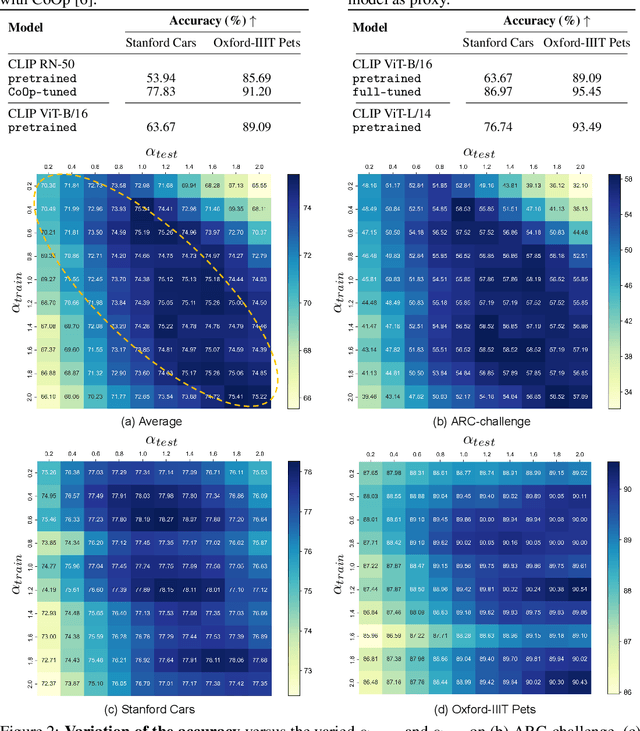
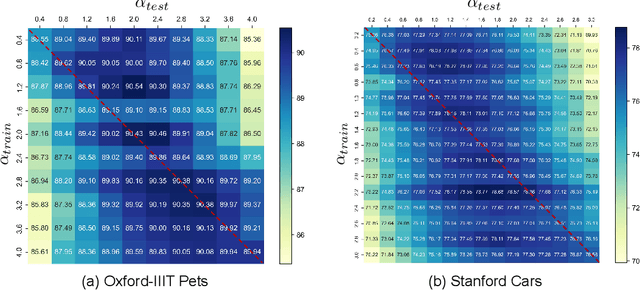
Abstract:Black-box tuning has attracted recent attention due to that the structure or inner parameters of advanced proprietary models are not accessible. Proxy-tuning provides a test-time output adjustment for tuning black-box language models. It applies the difference of the output logits before and after tuning a smaller white-box "proxy" model to improve the black-box model. However, this technique serves only as a decoding-time algorithm, leading to an inconsistency between training and testing which potentially limits overall performance. To address this problem, we introduce Consistent Proxy Tuning (CPT), a simple yet effective black-box tuning method. Different from Proxy-tuning, CPT additionally exploits the frozen large black-box model and another frozen small white-box model, ensuring consistency between training-stage optimization objective and test-time proxies. This consistency benefits Proxy-tuning and enhances model performance. Note that our method focuses solely on logit-level computation, which makes it model-agnostic and applicable to any task involving logit classification. Extensive experimental results demonstrate the superiority of our CPT in both black-box tuning of Large Language Models (LLMs) and Vision-Language Models (VLMs) across various datasets. The code is available at https://github.com/chunmeifeng/CPT.
Clinical Domain Knowledge-Derived Template Improves Post Hoc AI Explanations in Pneumothorax Classification
Mar 26, 2024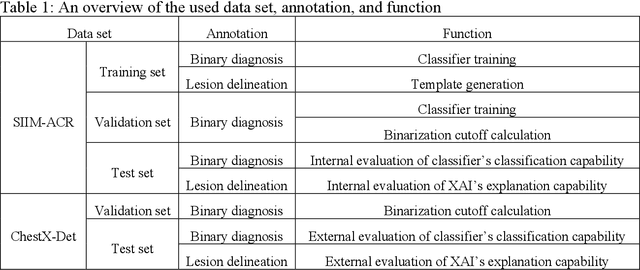



Abstract:Background: Pneumothorax is an acute thoracic disease caused by abnormal air collection between the lungs and chest wall. To address the opaqueness often associated with deep learning (DL) models, explainable artificial intelligence (XAI) methods have been introduced to outline regions related to pneumothorax diagnoses made by DL models. However, these explanations sometimes diverge from actual lesion areas, highlighting the need for further improvement. Method: We propose a template-guided approach to incorporate the clinical knowledge of pneumothorax into model explanations generated by XAI methods, thereby enhancing the quality of these explanations. Utilizing one lesion delineation created by radiologists, our approach first generates a template that represents potential areas of pneumothorax occurrence. This template is then superimposed on model explanations to filter out extraneous explanations that fall outside the template's boundaries. To validate its efficacy, we carried out a comparative analysis of three XAI methods with and without our template guidance when explaining two DL models in two real-world datasets. Results: The proposed approach consistently improved baseline XAI methods across twelve benchmark scenarios built on three XAI methods, two DL models, and two datasets. The average incremental percentages, calculated by the performance improvements over the baseline performance, were 97.8% in Intersection over Union (IoU) and 94.1% in Dice Similarity Coefficient (DSC) when comparing model explanations and ground-truth lesion areas. Conclusions: In the context of pneumothorax diagnoses, we proposed a template-guided approach for improving AI explanations. We anticipate that our template guidance will forge a fresh approach to elucidating AI models by integrating clinical domain expertise.
RLPeri: Accelerating Visual Perimetry Test with Reinforcement Learning and Convolutional Feature Extraction
Mar 08, 2024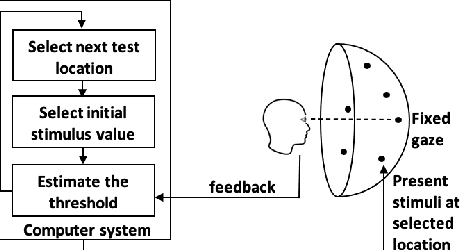
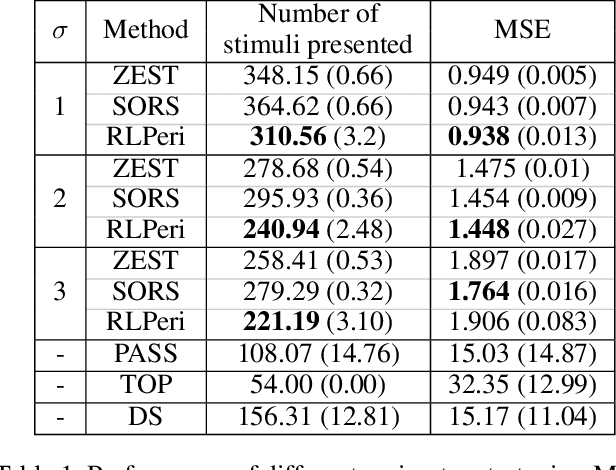

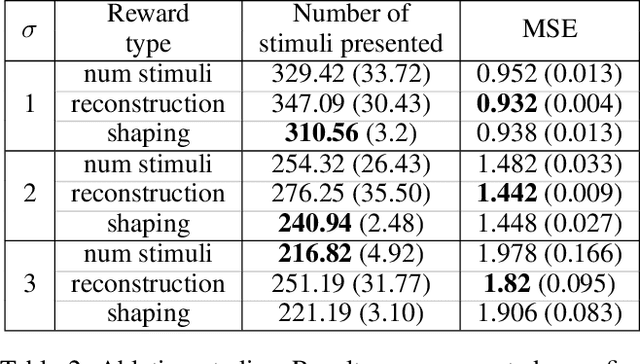
Abstract:Visual perimetry is an important eye examination that helps detect vision problems caused by ocular or neurological conditions. During the test, a patient's gaze is fixed at a specific location while light stimuli of varying intensities are presented in central and peripheral vision. Based on the patient's responses to the stimuli, the visual field mapping and sensitivity are determined. However, maintaining high levels of concentration throughout the test can be challenging for patients, leading to increased examination times and decreased accuracy. In this work, we present RLPeri, a reinforcement learning-based approach to optimize visual perimetry testing. By determining the optimal sequence of locations and initial stimulus values, we aim to reduce the examination time without compromising accuracy. Additionally, we incorporate reward shaping techniques to further improve the testing performance. To monitor the patient's responses over time during testing, we represent the test's state as a pair of 3D matrices. We apply two different convolutional kernels to extract spatial features across locations as well as features across different stimulus values for each location. Through experiments, we demonstrate that our approach results in a 10-20% reduction in examination time while maintaining the accuracy as compared to state-of-the-art methods. With the presented approach, we aim to make visual perimetry testing more efficient and patient-friendly, while still providing accurate results.
* Published at AAAI-24
 Add to Chrome
Add to Chrome Add to Firefox
Add to Firefox Add to Edge
Add to Edge